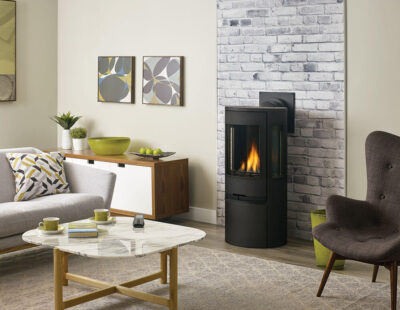An Easy Guide to Gas Fireplaces
The fireplace specialists at Berkeley Heat offer advice on choosing the perfect gas fireplace for your home along with information on the expected costs.
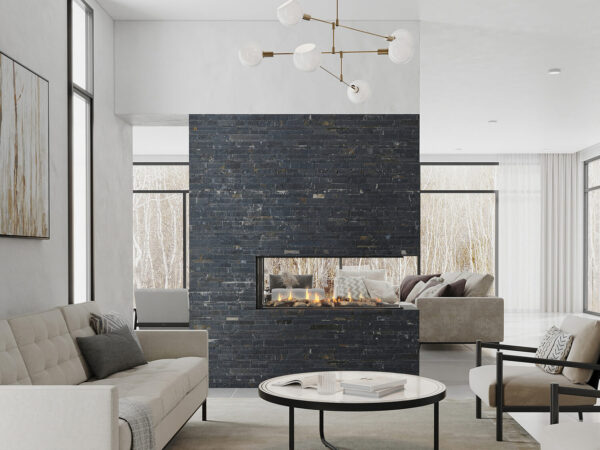
Envision the cozy warmth and inviting ambiance of a crackling fire, without the effort of chopping wood, managing flames, or dealing with ash cleanup! That’s the beauty of today’s gas fireplaces. Contemporary models feature incredibly lifelike flames, glowing embers, and efficient heating—all with just the push of a button.
Whether you want to update an existing wood-burning fireplace or create a new focal point, we’re here to help you choose the perfect gas fireplace for your space.
Read on to learn how gas fireplaces function, the various types of fireplaces available, important features to think about, maintenance tips, and more. When the temperatures drop, you’ll be set to unwind in front of a warm and convenient gas fireplace.
How Do Gas Fireplaces Operate?
Gas fireplaces provide the cozy ambiance of a wood-burning fire without the hassle of cleanup or upkeep. Instead of using wood, they operate on natural gas or propane. Here’s how they function:
- Fuel Delivery: A line connects to your home’s natural gas or propane supply, bringing fuel to the fireplace.
- Ignition: An electronic ignition system (or pilot light in some older models) ignites the gas, creating a flame.
- Combustion: The gas mixes with air and ignites, generating heat and flames that flicker around artificial logs.
- Venting: Byproducts such as water vapor and carbon dioxide are either vented outdoors or treated to reduce emissions.
Parts of a Gas Fireplace
The design of gas fireplaces can vary based on type, placement, and venting system, but they generally consist of the following basic components:
- Firebox: A metal enclosure that contains the burner, logs or other media, and often a heat exchanger.
- Ignition System: A mechanism that ignites the gas, either electronically or with a pilot light in older models.
- Burner: The part that mixes gas and air for combustion, producing flames.
- Media: Made from ceramic or other heat-resistant materials, often designed to resemble wood logs. Some models offer modern alternatives like stones or glass or stone.
- Glass Front or Metal Screen: In vented models, a tempered glass panel allows for a clear view of the flames while helping to retain heat. Ventless models may also feature a glass panel or a metal safety screen. Built-in and standalone models can have multiple glass panels for a see-through or panoramic effect.
- Venting System: In a direct-vent system, exhaust gasses are expelled through a pipe or duct. A natural vent system relies on the chimney’s draft to carry exhaust gases outside. Some models are entirely vent-free.
- Outer Trim or Surround: Some inserts come with an outer trim kit to cover gaps between the insert and fireplace opening. Freestanding models often feature a decorative frame made of stone, tile, or another non-combustible material around the firebox.
- Controls: A panel or remote that allows you to adjust the flame height, heat output, and other features.
- Blower: Some models include a fan that circulates warm air from the firebox into the room.
- Heat Exchanger: A system of metal fins or tubes that absorbs heat from the firebox and transfers it to the room air, enhancing the fireplace’s heating efficiency. Not all models include this feature.
- Oxygen Depletion Sensor (ODS): Found in ventless gas fireplaces, this sensor automatically shuts off the gas supply if it detects low oxygen levels in the room.
Venting Options
Gas fireplaces come with one of three venting systems: natural, direct, or ventless.
- Natural Vent: Natural or B-vent fireplaces utilize indoor air for combustion and expel exhaust gasses outside through a chimney or pipe. While this option is less efficient compared to others, it is the easiest choice for installing a gas fireplace within an existing wood-burning fireplace.
- Direct Vent: Direct vent fireplaces feature a sealed combustion system with two pipes that extend through the roof or an exterior wall. One pipe draws in outdoor air for combustion, while the other vents exhaust gasses outside. This setup is more efficient, improves indoor air quality, and offers greater placement flexibility.
- Ventless: Ventless or vent-free fireplaces burn gas so cleanly that they do not require any venting. Generally smaller and less powerful than vented models, they can be installed in nearly any location. However, ventless fireplaces are prohibited in California and some U.S. cities due to air quality concerns.
Types of Gas Fireplaces
There are four primary types of gas fireplaces, each with its own advantages and disadvantages.
- Gas Fireplace Inserts: These are designed to fit into an existing masonry fireplace.
- Built-in Models: These are integrated into a wall during construction or renovation.
- Stand-alone Gas Fireplaces: These provide the most flexible placement options.
- Log Sets: These offer the aesthetic of a fireplace at a lower cost and with significantly less heat output
Here’s a brief overview of the options:
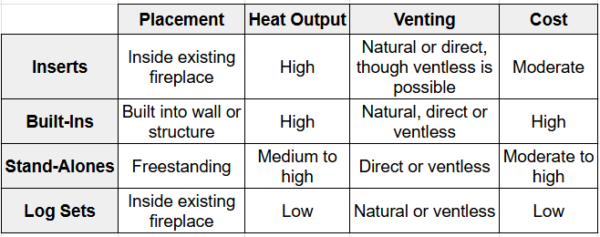
Gas Fireplace Inserts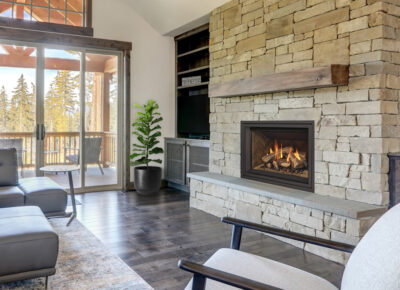
Gas fireplace inserts are made to fit into an existing fireplace opening, updating both its appearance and functionality. They are much more efficient than wood-burning fires, generating more heat with less fuel. Additionally, they can include improved safety features such as automatic shut-off and oxygen depletion sensors. However, vented models need professional installation, and design choices might be somewhat limited.
Built-In Gas Fireplaces
Built-in gas fireplaces are installed directly into the wall or structure of a home, providing a sleek and elegant focal point. They allow for highly customizable designs and deliver efficient heat output, without the need for an existing fireplace or chimney. However, built-ins are generally installed during construction or significant renovations, and they usually come at a higher cost than gas fireplace inserts. Additionally, it’s important to review local building codes before installing a ventless model.
Stand-Alone Freestanding Gas Fireplaces
Freestanding gas fireplaces don’t need an existing fireplace, allowing them to be installed almost anywhere—especially with a ventless model. These freestanding units are available in a variety of styles and sizes, and they can be relocated if necessary. Some models generate nearly as much heat as built-in fireplaces, making them suitable for primary or supplemental heating. However, stand-alone fireplaces require more floor space than inserts or built-ins, and their prices can vary significantly based on size, features, and design.
Log Sets
Log sets consist of a stack of ceramic logs placed on a gas burner pan, without a firebox. They fit inside your existing fireplace and create a lifelike flame effect. Some log sets vent through the chimney like traditional wood fires, while others are ventless. They are generally easy to install and cost-effective, but they generate significantly less heat compared to other gas fireplace options.
Benefits of Gas Fireplaces
Wood-burning fireplaces create a wonderful ambiance, but they can’t match the hassle-free efficiency of gas options.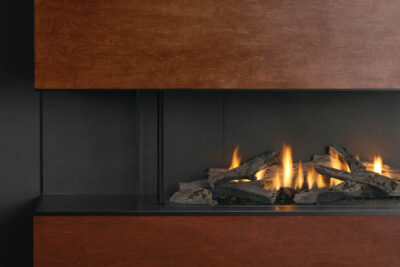
Effortless convenience: Switching from a wood-burning fireplace to a gas insert means you can eliminate the demanding tasks of splitting, stacking, and hauling wood. There’s no need to build or maintain a fire, and you won’t have to manage messy ashes or persistent smoky odors. With just a remote control, you can easily start, adjust, or extinguish the flames.
Precise temperature control: Many gas fireplaces feature thermostat controls that let you set and maintain your preferred room temperature effortlessly. The flame size adjusts automatically to provide the right amount of heat, ensuring comfort without wasting energy.
Enhanced energy efficiency: Wood-burning fireplaces are often inefficient, as much of the heat escapes through the chimney. In contrast, gas fireplaces can achieve efficiency ratings of up to 90%. Direct-vent models are particularly effective, retaining up to 70% of the heat inside.
Versatile placement: Unlike wood-burning fireplaces that require a chimney, gas fireplaces can be installed almost anywhere in your home, including upstairs bedrooms, basements, and even outdoor spaces. This flexibility opens up a variety of design options, allowing you to enjoy the warmth and ambiance of a fire in any area.
Clean and safe heating: The Environmental Protection Agency (EPA), through its Burn Wise program, recognizes natural gas as a “more efficient, cleaner way to heat homes” compared to burning wood. Gas fireplaces do not produce any smoke or creosote, reducing the risk of chimney fires. Many models also come equipped with safety features like oxygen depletion sensors and automatic shut-off mechanisms.
Choosing the Right Gas Fireplace
Finding the ideal gas fireplace requires considering several important factors, including your budget, fuel type, venting options, and the features you want.
Budget
Gas fireplace prices can vary significantly, starting at around a couple of hundred dollars for a small log set from large big box home improvement store and ranging from $2,300 to $8,000* for a gas fireplace insert. Evaluating your budget in advance can help you refine your choices. Remember to include installation costs in your calculations as well.
* Unless otherwise noted, all cost data was sourced from contractor estimates used by Angi.
Natural Gas or Propane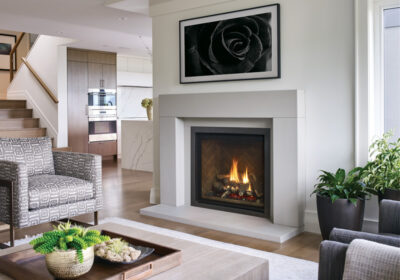
Gas fireplaces operate on either natural gas or propane, both of which burn cleaner than wood or coal. Natural gas is usually less expensive per unit of energy but depends on utility pipelines that may not be accessible in all areas. Propane has a higher upfront cost but offers cleaner and more efficient combustion.
Heat Output (BTUs)
The heat output of your fireplace, measured in British thermal units (BTUs), should be appropriate for the size and climate of the area you wish to heat. Gas fireplaces offer a broad range of heat output, typically between 7,000 and 60,000 BTUs. To find models that provide sufficient heat for your room, multiply the floor area (in square feet) by the ceiling height (in feet) and your BTU zone (refer to the map).
Vented vs. Ventless
A gas fireplace doesn’t emit smoke or odors, but its flames do produce pollutants, including carbon monoxide and nitrogen and sulfur oxides. Vented fireplaces expel these emissions outside through direct or natural venting.
Vent-free fireplaces don’t require any venting and lack a flue, allowing for installation in virtually any location. They are up to 99% efficient since all the heat remains in the room; however, this also means that all pollutants stay inside.
Due to air quality concerns, indoor units are designed to burn as cleanly as possible, but they may not be permitted in all areas. Generally, direct venting is considered the safest and most efficient option.
Aesthetics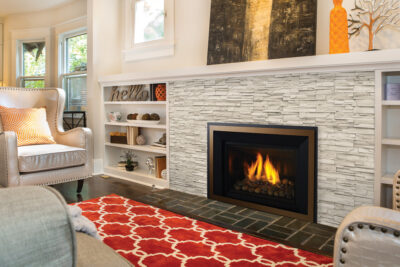
With customizable surrounds, finishes, and media options, you can tailor your gas fireplace to blend seamlessly with your existing décor or serve as a bold statement piece.
Traditional designs often include realistic log sets, black ceramic “coal” pieces, glowing embers, and ornate mantels, capturing the charm of a classic wood-burning fireplace. If you prefer a rustic aesthetic, consider a stone or brick surround paired with a roaring flame for a cozy cabin atmosphere.
Modern fireplaces, on the other hand, may feature sleek lines, minimalist frames, and unique media such as fire glass or crystals for an elegant look. Linear fireplaces that provide panoramic views of the flames can create a striking focal point.
Features to Consider
These upgrades improve a fireplace’s convenience, comfort, and appearance:
- Variable flame height adjustment: Lets you customize the heat output, from a gentle flicker to a full roaring fire.
- Wall thermostat control: Automatically regulates the fireplace’s heat output based on your desired temperature, which can be set manually or via a handheld remote.
- Electronic ignition: Removes the need for a pilot light, potentially saving you up to $10 per month on fuel costs.
- LED accent lighting: Creates a realistic flickering effect inside the firebox.
- Battery backup: Ensures the fireplace can ignite during a power outage.
- Built-in fan: Draws in indoor air, circulates it behind the firebox, and pushes out hot air, quickly warming the room.
Gas Fireplace Installation and Maintenance
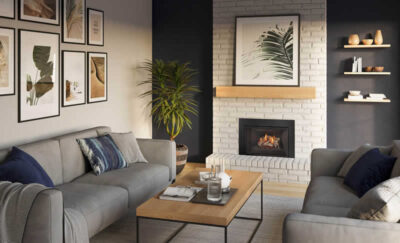 We recommend hiring a National Fireplace Institute (NFI)-certified technician for installation. A professional will ensure that the fireplace is properly connected to the gas line and meets local building codes. Depending on your area, you may also need permits and inspections for gas fireplace installation.
We recommend hiring a National Fireplace Institute (NFI)-certified technician for installation. A professional will ensure that the fireplace is properly connected to the gas line and meets local building codes. Depending on your area, you may also need permits and inspections for gas fireplace installation.
If you have a vented fireplace, make sure the venting system is correctly installed and appropriately sized for your model. For direct-vent fireplaces, the vent pipes should be sealed and exit outside. For natural-vent fireplaces, ensure that the chimney or vent pipe is in good condition and free of blockages.
Clean and safe heating: The Environmental Protection Agency (EPA), through its Burn Wise program, recognizes natural gas as a “more efficient, cleaner way to heat homes” compared to burning wood. Gas fireplaces do not produce any smoke or creosote, reducing the risk of chimney fires. Many models also come equipped with safety features like oxygen depletion sensors and automatic shut-off mechanisms.
Maintenance Tips
Gas fireplaces require minimal maintenance, but routine cleaning and inspections can help prolong their lifespan. Here are our recommendations:
- Annual inspections: Schedule an annual inspection with a qualified technician. They will check for gas leaks, clean the burner and pilot assembly, test safety features, and ensure everything is functioning correctly.
- Regular cleaning: Clean the glass front of your fireplace regularly to prevent soot buildup. Dust the firebox and surround using a soft cloth or brush, and inspect the venting system for any blockages or damage.
- Leak checks: Periodically check for gas leaks by applying a soapy water solution to the connections and looking for bubbles. If you find a leak, turn off the gas supply and contact a professional immediately.
Safety Considerations
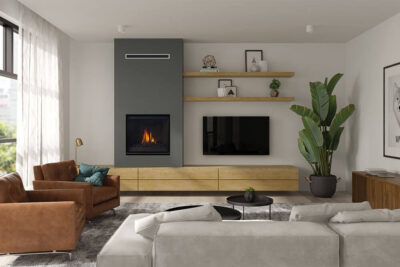 While gas fireplaces are generally safe and convenient, it’s important to be aware of potential safety hazards and take precautions.
While gas fireplaces are generally safe and convenient, it’s important to be aware of potential safety hazards and take precautions.
- Carbon monoxide: Gas fireplaces can produce carbon monoxide, an odorless and poisonous gas. Install and maintain carbon monoxide detectors in your home to alert you to any problems.
- Flammable materials: Keep flammable materials—such as furniture, curtains, and decorations—a safe distance away from the fireplace.
- Children and pets: Never leave children or pets unattended near an operating fireplace, and consider using a fireplace screen to prevent accidental contact with the flames.
- Gas leaks: If you smell gas or suspect a leak, turn off the gas supply and contact a professional immediately.
Where To Place a Gas Fireplace in Your Home
Gas fireplaces provide exceptional versatility, enabling you to turn any room into a cozy and welcoming space. Here are some creative ideas for incorporating gas fireplaces throughout your home, from traditional living rooms to unexpected nooks.
- Bathroom: Imagine a fireplace above the bathtub! With a mo
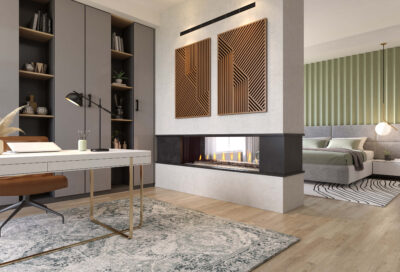 dern double-sided unit, you can enjoy flames visible from both the bathroom and the adjacent bedroom.
dern double-sided unit, you can enjoy flames visible from both the bathroom and the adjacent bedroom. - Bedroom: A fireplace adds a romantic touch, and with a remote, you can adjust the flame size and room temperature without even getting out of bed.
- Patio: Stay warm on cool evenings and enhance your outdoor ambiance with a low-profile gas fireplace—no chimney required. Outdoor, vent-free units come without BTU restrictions or oxygen-depletion sensors.
- Living Room: In this classic fireplace location, gas allows for designs that weren’t possible before, like a linear wall of fire that burns through a bed of glass.
- Basement: Direct-vent gas fireplaces are ideal for below-grade recreation rooms, where wood-burning fires may struggle due to poor draft.
In Summary
Gas fireplaces provide an appealing combination of convenience, efficiency, and visual charm. Whether you’re looking to update an existing fireplace, create a striking focal point, or enhance your outdoor living area, a gas fireplace can turn your home into a warm sanctuary.
As you explore your options for a new gas fireplace, be sure to consider your budget, desired heat output, venting choices, and aesthetic preferences. It’s wise to consult a qualified professional for proper installation and maintenance, and always prioritize safety when using your fireplace.
Keeping Warm During Power Outages with your Fireplace
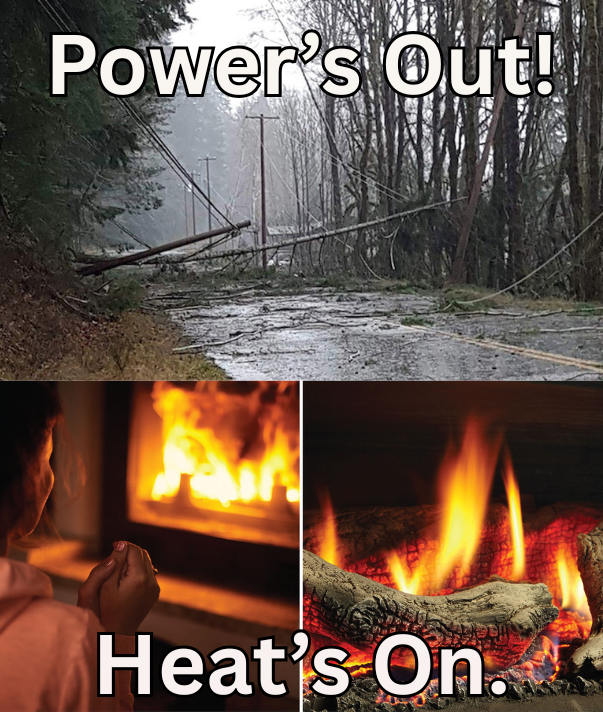
Designed to operate without electricity, Regency gas, wood, and pellet fireplace products provide dependable heat when it matters most.
Trusted by thousands of families across America, these fireplaces offer peace of mind during power outages—delivering warmth, comfort, and reliability no matter the weather.

Formerly Tubmakers, Berkeley Heat has been serving the Bay Area since the 1970s.
Today, we’re proud to be California’s #1 Regency fireplace store.
As an authorized Key Dealer, we sell more Regency fireplaces than anyone else in California—and we feature the largest Regency fireplace showroom in the entire state!
Looking to add a modern Regency fireplace to your home? Visit our showroom to explore over 20 live-burning displays and experience the beauty and performance in person.
We partner with trusted, independent NFI-certified contractors to ensure your fireplace is installed professionally and efficiently—so you can start enjoying it sooner.

